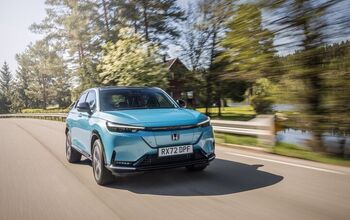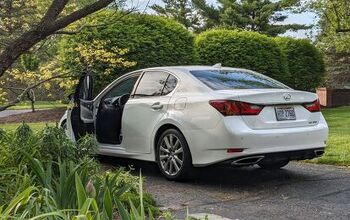No Fixed Abode: What If They Held a Cheap-Car Party and Nobody Came?

Just a couple of weeks into my ECO 101 class, I knew that something was terribly wrong.
At the age of nineteen, I’d already worked for a few dealerships and I was on the way to opening up my own bike shop. Yet I knew at some level that I was profoundly ignorant of the levers that truly move the world. So I signed up for an economics class to learn about those levers.
I learned a lot of theories and concepts in that semester, most of them “proven” by long experience if not by experiment; much like climate science and astronomy, economics is one of those disciplines where much of the scientific method is rendered inaccessible for obvious reasons. Even as a kid, however, I could tell that pure economic theory, like pure Marxism, had no relation to the real world. I was shown a lot of charts where imaginary widget factories maximized output until they broke even on the last widget they made. I heard a lot about elastic and inelastic demand. Things were shown to be fungible, or perhaps not. But if there was a direct connection to the way business worked in my daily life, it must have been made of Larry Niven’s shadow-square wire.
Now, in my forties, I have come to the conclusion that ECO 101 should not be taught to anyone who has not already taken ECO 102, or perhaps owned a business, or maybe reached the age of retirement. ECO 101 contains information that is too dangerous to be used or acted upon in its purest form. The real world doesn’t play by the rules you learn in that class.
Want proof? Here’s some: apparently people won’t buy a brand-new $16,950 car if it’s listed for half price.
The world of automotive pricing, like the world of wristwatch pricing, works on some bizarre rules which exist nowhere else. Periodically, my brother tries to tell all of you examples of how that world really works, only to be blitzed by people who are still living in the world of ECO 101.
“How can dealers keep the price of used cars above a certain level? THE MARKET WILL CORRECT THAT!” Yet the prices of used cars continue to rise even as the lease companies flood the auctions with bargain-priced junk. It’s weird stuff that has elements of chaos theory in it. Too many variables to map. You’re left with the results of their interactions.
Most of this happens because customers don’t behave like the rational automatons of ECO 101 when it comes to buying cars. Here’s an example. Nearly-new Toyotas often sell at dealers for more than brand-new examples. The reason for this won’t be found in your textbook, but here it is: There is a group of people out there that has almost a talismanic faith in the idea of saving money by purchasing a nearly-new car. The supply of nearly-new Toyotas is fairly low compared to the supply of new Toyotas, so their prices are often higher — and that part is straight out of the textbook. It’s just that there is no textbook capable of acquainting you with the breadth and scope of human delusion, except perhaps for this one.
The picture that heads this article is an example of a different market distortion. You can see that this new Elantra is being marked down from $15,999 to $10,999. Staggering, right? That’s the shot, but here’s the chaser: that’s $10,999 CDN. Which is… under $8,400 USD as of this writing.
For $8,400, you can get a new Hyundai that lacks A/C or an automatic transmission but which does have heated seats. That’s used-car money; in fact, it is six-year-old Elantra with 85,000 miles money. If you want, say, a five-year-old Elantra with 70,000 miles, be prepared to pay more.
I called a couple of Ohio used-car shops and they confirmed that used Elantras are not that hard to sell. Not easy like used Corollas, which “have a nerd waiting to buy them when they come in on trade,” but easier than used Sentras, which are “for people who have found the bottom of the beacon score.” I asked one of the dealers if they could sell brand-new Elantras for $9,999. “All day and every day.”
So why is the Canadian dealer in this example out there on Facebook absolutely begging people to come out for a test drive? The answer is simple and a bit unpleasant. Decades’ worth of marketing saturation, “great advice” from a thousand self-anointed financial gurus, and subconsicous-level preconceptions regarding class and race have all conspired to create entire cohorts of “used-car customers” who don’t think they are entitled to, or capable of buying, a new car.
Does it make sense for people of less-than-Kardashian-esque means to buy a used car? Absolutely, when it is a used car from a private seller at a competitive price. There is no reason to buy a 2012 Elantra from a corner lot at a $4k post-auction markup. Except, of course, for the fact that the banks and the used-car dealers have all conspired to remake the market in their own image.
Your ECO 101 textbook will never tell you about the agreements between corner-lot dealers and “Loan Zone”-style financiers that restrict the availability of 560-beacon-tier financing to cars sold through a dealer. Hell, even the big banks will ding you for buying a private car; when I took out a credit union loan to buy my 1995 Porsche eighteen years ago, I had to pay a two-percent bump because I wasn’t taking delivery at a dealer. I did the math; $29,900 for a private-sale 911 made more sense than $38k for that same car from a Porsche dealer, regardless of interest rate. But I grew up as a child who was taught to do the math. Not everyone did.
“Wait a minute, Jack… you’re playing your own games with us, comparing brand-new Canadian Elantras with used American Elantras.” I confess that I did play that game, just to see if you’d notice. Here is a Canadian used-Elantra result. An entirely average listing for a 2013 Elantra in Toronto. New-car money, with just a little more equipment.
It’s a strange world, isn’t it? Used cars selling for more than new ones, often side-by-side at the same dealer. It doesn’t make any sense on its face, but once you get a sense of how the sausage is really made, some of it starts to become clear. The market for new cars is not nearly as free as we might like. Everybody from the government to Suze Orman’s publisher has a finger on the scales. Which doesn’t exactly explain why I can’t go buy a new Elantra for $8,400 at my local dealer — but maybe it explains why nobody would bother to take advantage of it anyway. Don’t worry; someday I’ll figure it out. And I’ll write it all down in a textbook for a new class. We can call it ECO 100.5: They Don’t Think It Be Like It Is, But It Do.
[Image: Steele Hyundai/ Facebook]
(Many thanks to Mark Stevenson, former TTAC Managing Editor who is now pushing tin at Steele Hyundai. If you’re in the Great White North and you’re smart enough to buy a stick-shift Elantra for giveaway pricing, you should buy it from him! — JB)

More by Jack Baruth
Latest Car Reviews
Read moreLatest Product Reviews
Read moreRecent Comments
- ToolGuy There was a time when in a place called America there were roads, and they were paved, and they were paved smoothly enough for a vehicle like this. Perhaps our next President will bring back that concept.
- ToolGuy I suppose I will listen before commenting. (TG, what a fair-minded dude!)
- ToolGuy "The technology is much more advanced to be better than a role model driver,”• Do any of you know what a "role model driver" is? No, I guess you wouldn't. 😉
- ToolGuy I might be Batman.
- Lou_BC Well, I'd be impressed if this was in a ZR2. LOL


































Comments
Join the conversation
I leased a Ford F-150 in 1997 as strictly an exercise in price. Ford was taking away their credit card money I had accrued. In a lease, they pay you back for any "free" or discounted options at full price in the residual. So I hunted down an F-150 with a New England Patriot package and a straight six with a manual. The package was about $200 and they bought it back for $800. The engine/trans got you free air conditioning that they bought back. I did a two year prepaid lease. About $1000 out of pocket and $2K from the evaporating credit card. Beat it up a bit hauling 35 loads of brush from an ice storm. Two years later I turned it in in Ann Arbor.
After reading about Canadian dealer practices, likely what you have here is the lowball offer and then loads of dealer addons - I bet there is fine print here somewhere - it has to be disclosed. The actual price the car will sell at is likely around $14999 after the interesting Canadian sales practice fees are added. And don't forget that outrageous biweekly payment! More places to get the customer.